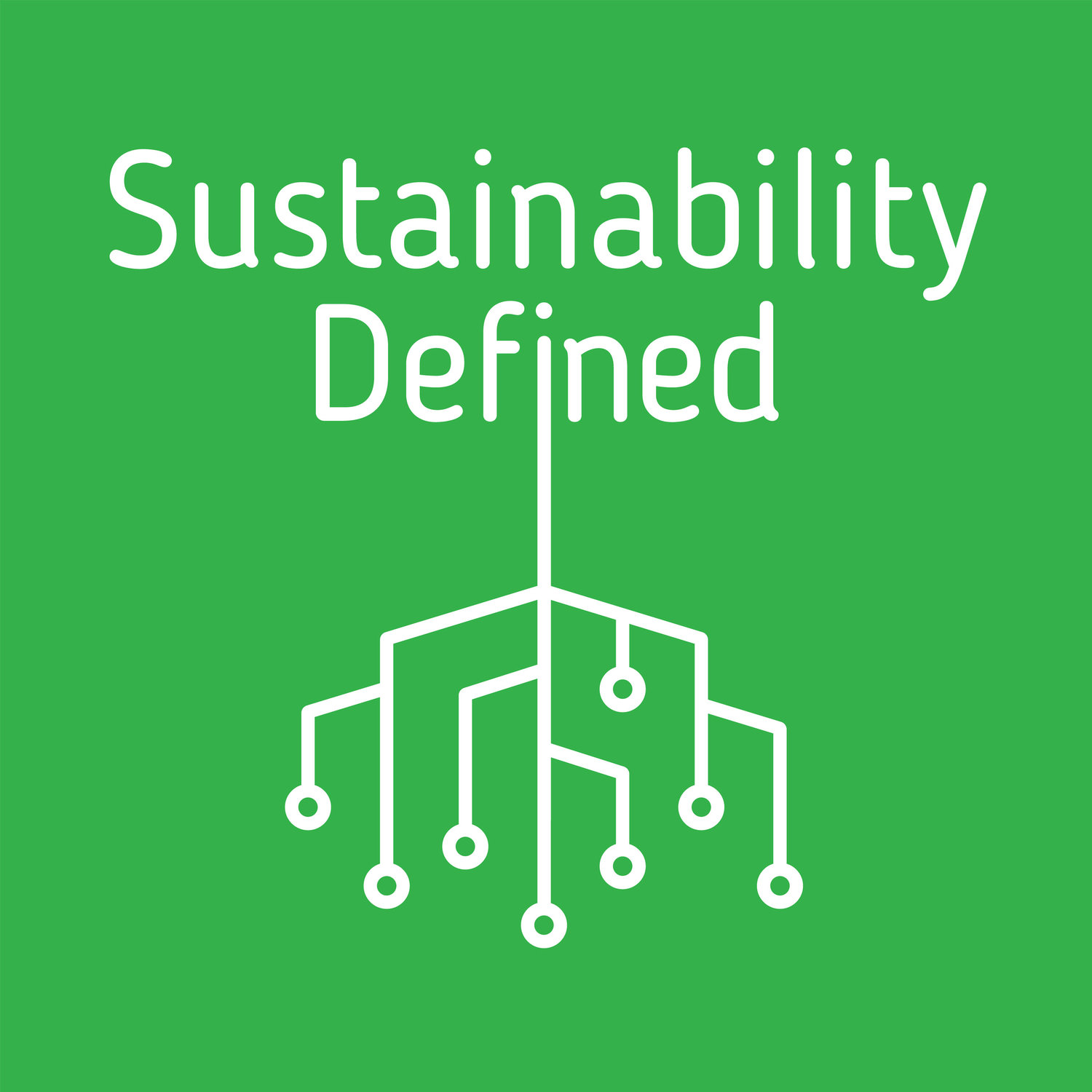Episode 40: University Sustainability with Penn State University
Grab your notebook and #2 pencil... we're going back to school! Through their operations, research, and course offerings, universities have a large carbon footprint and play a major role in advancing sustainability. Join us as we dive into the nuances of sustainability on college campuses, including a special focus on Penn State University, where one of its professors, Lucy McClain, includes our podcast in her course curriculum. In this episode, you'll hear from Dr. Paul Shrivastava, PSU's Chief Sustainability Officer, Professor McClain, and two of the students in Professor McClain's class who had the privilege of listening to our episodes (and bad jokes) for class. By the end of the episode, you'll be able to ace a test on university sustainability and identify how you can improve sustainability efforts at your current school or alma mater.
Learn more about environmental awareness here!
Episode Intro Notes
What We’ll cover
What do we mean by university sustainability and what is its history?
Why should we care if universities take sustainability seriously?
Who on college campuses normally leads the sustainability efforts?
How can universities become more sustainable?
Which college campuses leaders sustainability?
How can you get your campus or alma mater to be more sustainable?
Penn State University, Paul Shrivastava, Lucy McClain, Students
What do we mean by university sustainability and what is its history?
We’ll refer to how a university operates on its campus and also how its actions affect the movement toward sustainability beyond the confines of its campus.
The history of sustainability across universities is still rather young. It wasn’t until the late 1990s and early 2000s that you started to see specific examples of colleges partaking in the sustainability discussion. For example, in 1996 Ball State University hosted the first the Greening of the Campus Conference, which was an interdisciplinary conference focusing on the integration of sustainable practice and teaching into the university environment. Its initial meeting had over 200 attendees from 5 countries.
Today you’d be hard pressed to find a major university that doesn’t have a sustainability office.
Why should we care if universities take sustainability seriously?
Well, because they have a massive carbon footprint. In 2005 (most recent data we’ve seen), US higher ed institutions (aka colleges and universities) accounted for approximately 121 million metric tons of CO2, which represents nearly 2% of total annual US GHG emissions.
The good news is universities have taken action on climate. The American College and University Presidents Climate Commitment was launched in 2006. Among other items, the agreement committed signatories to take immediate steps to reduce greenhouse gas emissions, integrate sustainability into their curriculums, and make their action plans, inventory and progress reports publicly available. There were 12 founding signatories and today it has close to 700.
Still not convinced? Let’s break down university footprints and their contributions to the sustainability field.
Lots of people (and resource use) on university campuses
In 2016, there were 16.9 million undergraduates (or approximately 5.2% of the U.S. population) enrolled in the U.S. That’s just undergraduates! Nevermind the graduate students, faculty, or staff.
Fun land fact (our favorite kind of fact). The largest contiguous campus in the U.S. is Berry College in Rome, GA at 27,000 acres. This is nearly twice the size of Manhattan!
The research universities generate can drive big changes
For example, a team of researchers at Yale and China’s Peking University synthesized a nanocoagulant to more effectively and efficiently remove water contaminants, which is critical to addressing global water scarcity. The researchers were inspired by Actinia, a sea organism that ensnares its prey with its tentacles
Training the sustainability leaders of the future - like the ones we’ll be speaking with later!
Back in 2015, the University of Vermont put in a requirement that all undergraduate students must satisfy a sustainability requirement before they can graduate.
There are also whole schools of sustainability. Arizona State University was the first university in the US to create a specific sustainability school back in 2006.
University endowments control a massive amount of capital
Often universities have a large amount of savings (i.e., endowments), that they need to invest somewhere for an extended period of time. How much money are we talking? In 2015 the market value of US university endowments was $547 billion, which is about the size of Sweden’s GDP!. Often, endowment sums are public knowledge, so you can run a quick google search to see how large your university’s is.
In the early 2010’s, there were movements across college campus for these endowments to divest from fossil fuels and improve their Environmental, Social, and Governance (ESG) holdings. There has been growth, but it’s been uneven. One annual survey of colleges found that just 16 percent of the 809 participants included investments in their portfolios with high ESG rankings, which was down one percent from the previous year.
Who on college campuses normally leads the sustainability efforts?
There are often whole offices of sustainability at Universities. But if those aren’t present, there are often grassroots sustainability initiatives led by student groups, faculty members, or other departments to push the same sorts of agendas.
Note though that sometimes it’s good to be able to act outside of the university budgeting and approval process, so these can be helpful even when there is an established sustainability office. In fact, our personal friends working in university sustainability have noted a trend to move away from sustainability as the responsibility of a single office. This is evident in Indiana University’s rebranding of its sustainability effort as SustainIU, which deemphasizes IU’s sustainability office and its staff.
How can universities become more sustainable?
There are many ways for individual campuses to be more sustainable. There’s no secret sauce here just for universities (mmm...secret sauce). They parallel recommendations that are often made to other businesses or organizations.
1) Alternative transportation
How students get around campus is a big deal, especially on larger campuses. Cleaner buses and bikeshare and scooter offerings are ways to make transit on campus more sustainable. Shout out to Cornell for their snazzy Big Red Bikeshare program.
Investments in alternative transit often provide both financial and sustainability benefits. Take Duke’s new zero emission buses as an example. NextGen Transport News notes that “Dukes new zero-emission buses… release zero tailpipe emissions, require no oil changes, and use no liquid fuels. Duke expects to save approximately $924,000 in maintenance, fuel and vehicle costs over the lifespan of the two buses.”
2) Facility upgrades
A no-brainer, really. For example, universities can pursue LEED certifications for new and existing buildings (shoutout to our Greencon Keynote!), install things like low flow toilets and showers in dorms, automated lights, building control and automation systems, and position more recycling and compost bins around campus.
More universities are installing renewable energy on campus. For example, the University of Hawaii Maui College will be the first to go 100% renewable with on-site energy generation when its solar plus storage installation comes online in 2019.
3) Evaluating suppliers and providers
Universities can include in food service contracts certain sourcing guidelines and organic food requirements. For example, Trinity University in February 2019 added a clause to its food service contract with Aramark requiring a focus on sustainable food sourcing.
4) Bolster initiatives to engage and educate students and others at the university
For example, over 160 universities have introduced Meatless Monday programs to encourage people to reduce their meat consumption.
5) Start or grow course offerings focused on sustainability or environmental science
For universities unsure of where to start here, the Sustainability Curriculum Consortium can help schools provide professional development for faculty and develop its sustainability curriculum. It offers advisory services, webinars, and an annual faculty conference.
So we’ve given you five reasons how universities can become more sustainable. For more on why they should implement these practices, check out a report from the Association for Advancement of Sustainability in Higher Education (AASHE), which states 6 main reasons as to why university sustainability is the right thing to do. Linked on our website.
Which college campuses leaders sustainability?
So as people love to do with universities, you guessed it, there are rankings! AASHE has a Sustainable Campus Index and its STARS system. Other reports have come out from Forbes, the Princeton Review, and Sierra Club.
Shout out to Dickinson and College of the Atlantic for appearing in the top 10 of the AASHE sustainable campus index and top five of the Forbes and Princeton Review.
How can you get your campus or alma mater to be more sustainable?
First, consider your donations. See if your university has an option to earmark your donation for specific objectives or actions that are related to sustainability.
Also, use your voice. Tell your alma mater this matters to you and provide feedback on their sustainability goals and objectives when the opportunity arises.
Take sustainability classes and tell the registrar and others you want such classes.
Lastly, if you are still a student, get involved! Join a campus sustainability club and share your ideas. These clubs often have a budget to throw events on campus or send you to events, and they are often organizing actions to get the university to take greater sustainability actions. If there isn’t a sustainability club, start one! Looks good on a resume too I am sure.
Our Guests
We’ll first be speaking with Dr Paul Shrivastava, who is the Chief Sustainability Officer of Penn State University. He is also the Director of Penn State’s Sustainability Institute, and a Professor of Management at the Smeal College of Business. He’s a busy guy! On top of these roles, he also has an impressive history as a hardware and software entrepreneur, oh and he’s also published 17 books and over 100 articles.
Next up we’ll be speaking with Lucy McClain, who is the Science and Education Program Director at Shaver’s Creek Environmental Center at Penn State. She’s the Penn State professor who catalyzed this episode - she reached out after incorporating our show throughout her curriculum and has great insights into how the podcast worked in her course, and whether her students actually laughed at our jokes.
We’ll then connect with two students who *should have* laughed at these jokes to hear their impressions of the podcast in an academic setting - Ryan Dincher and Bryn Wambaugh.




